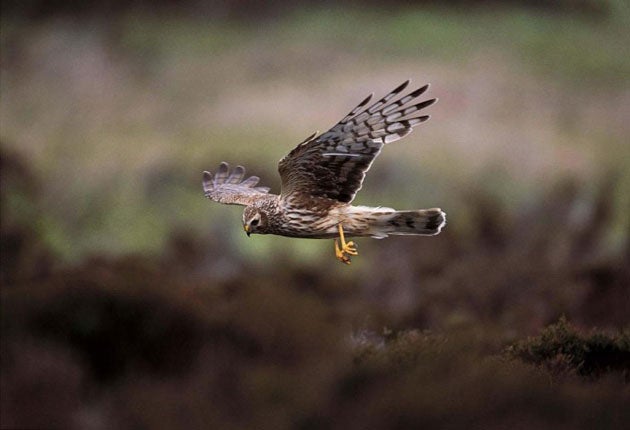Gamekeepers 'kill off' last of hen harriers
Rare bird being driven to extinction in England

Hen harriers are being driven to extinction in England by illegal persecution on grouse moors, according to the Government's wildlife watchdog. The long-winged, long-tailed birds of prey are among the country's rarest species.
Natural England says moorland owners and shooting managers are threatening the survival of the birds by illegally removing their eggs and burning their nests.
In one 12-month period, six birds fitted with satellite transmitters were tracked as they flew from one of the hen harrier's strongholds on Bowland Fells, Lancashire, into parts of the north Pennines managed as grouse moors. They disappeared off the map.
The authors of Natural England's study, A Future for the Hen Harrier in England?, said that on several occasions, they have seen "masked and/or armed individuals" disturbing nest sites.
The study outlines six years of monitoring, largely in the Pennines, and provides "compelling evidence" of illegal hen harrier persecution in England. The bird has become an "emblem of man's callous disregard" for wildlife, according to Sir Martin Doughty, Natural England's chairman.
"Hen harriers are being persecuted while they attempt to nest and birds are not returning to their breeding areas the following spring," he said.
The only grouse moorland or game rearing area seeing rising hen harrier numbers is Bowland, where sympathetic landowners and gamekeepers work with the Royal Society for the Protection of Birds. In the past six years, the comparatively tiny area has accounted for more than two-thirds of all the 127 hen harrier breeding attempts recorded by Natural England.
"Throughout the rest of England, only 19 breeding attempts were recorded on grouse moors, in spite of the suitability of the habitat," the agency reported. "Persecution is the reason for the systematic disruption of hen harrier breeding attempts in areas that provide extensive and very suitable habitat."
The hen harrier became extinct in the Victorian era but recolonised Scotland in the interwar years. They began returning to England in the 1970s . there are now about 800 breeding pairs in the UK and Isle of Man, with 630 of those in Scotland.
Natural England is considering re-introducing hen harriers to the lowland part of its former range to see if the birds have better breeding success.
Edward Bromet, chairman of the Moorland Association, which represents grouse moor owners in England and Wales, said his organisation would not support anyone who persecutes the birds. He said: "We are working very hard with them [Natural England] to find a solution to the conservation status of hen harriers."
Join our commenting forum
Join thought-provoking conversations, follow other Independent readers and see their replies
Comments